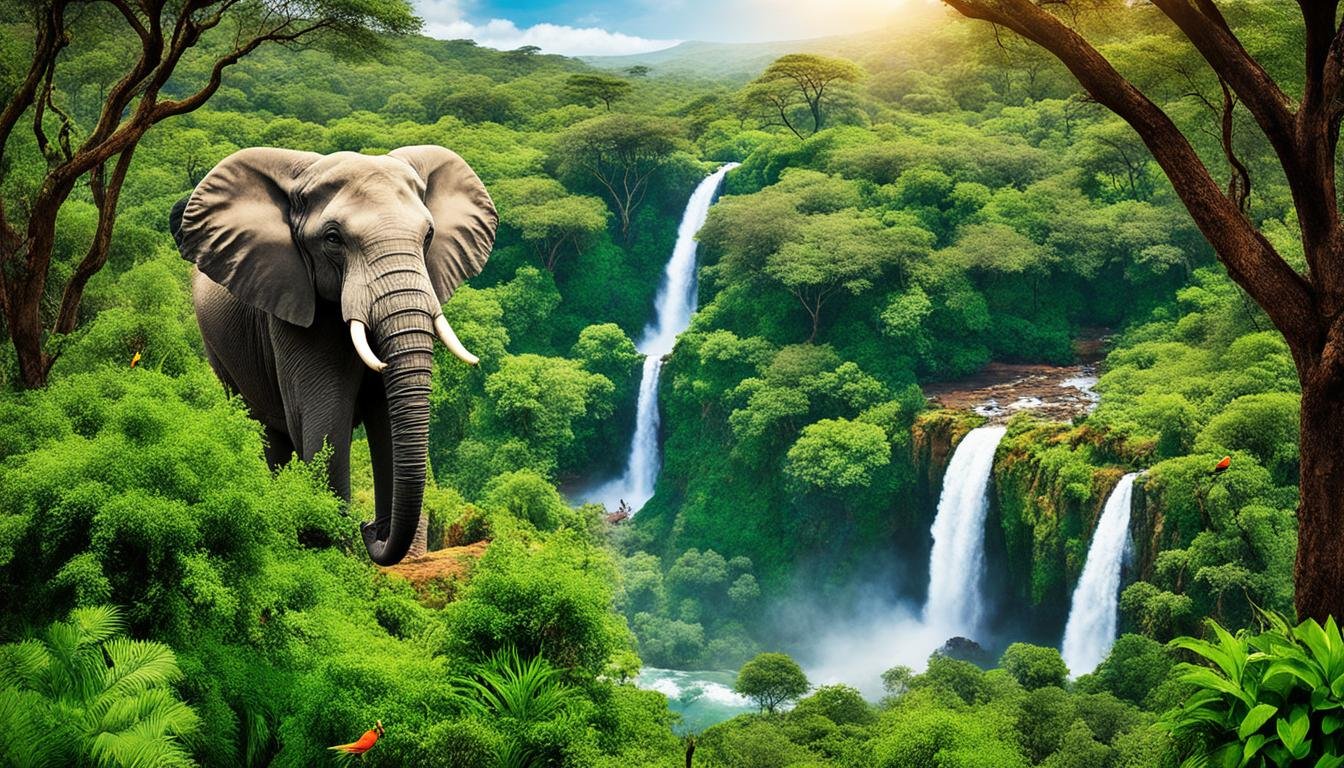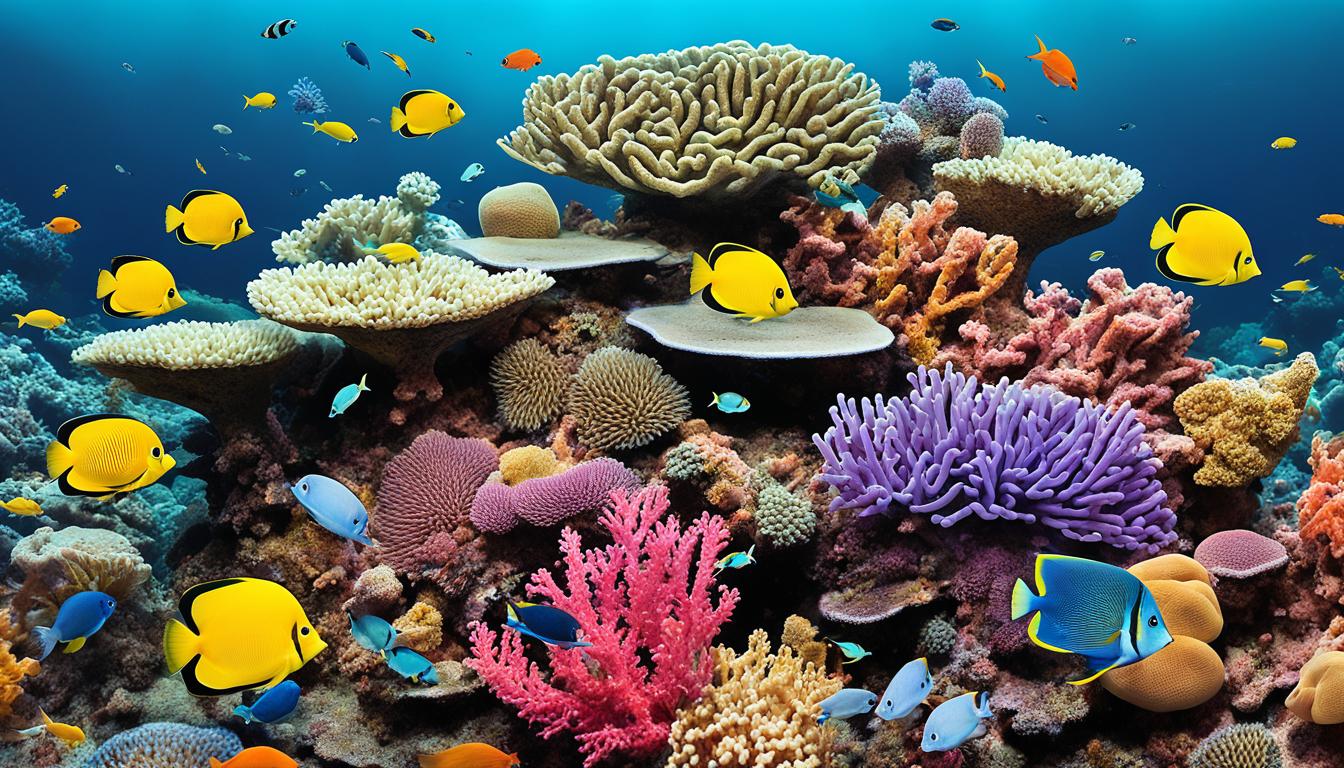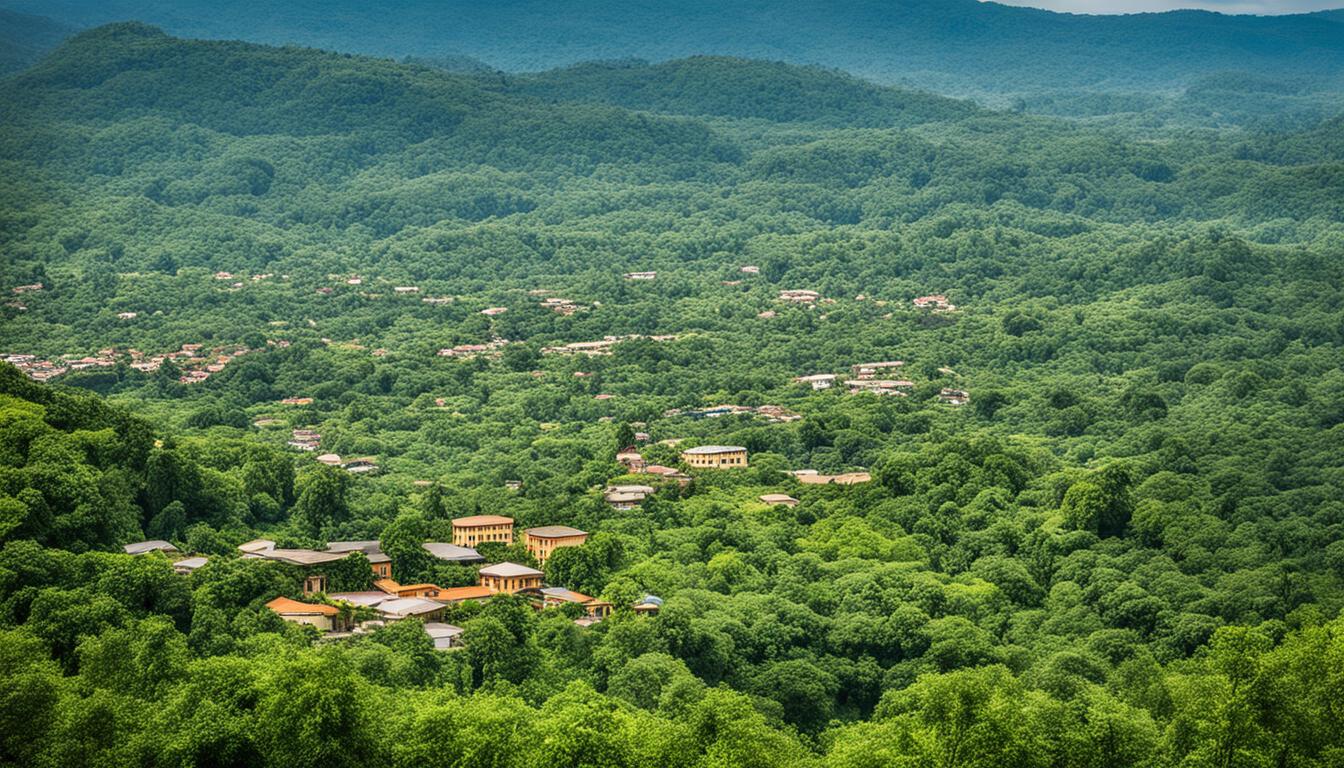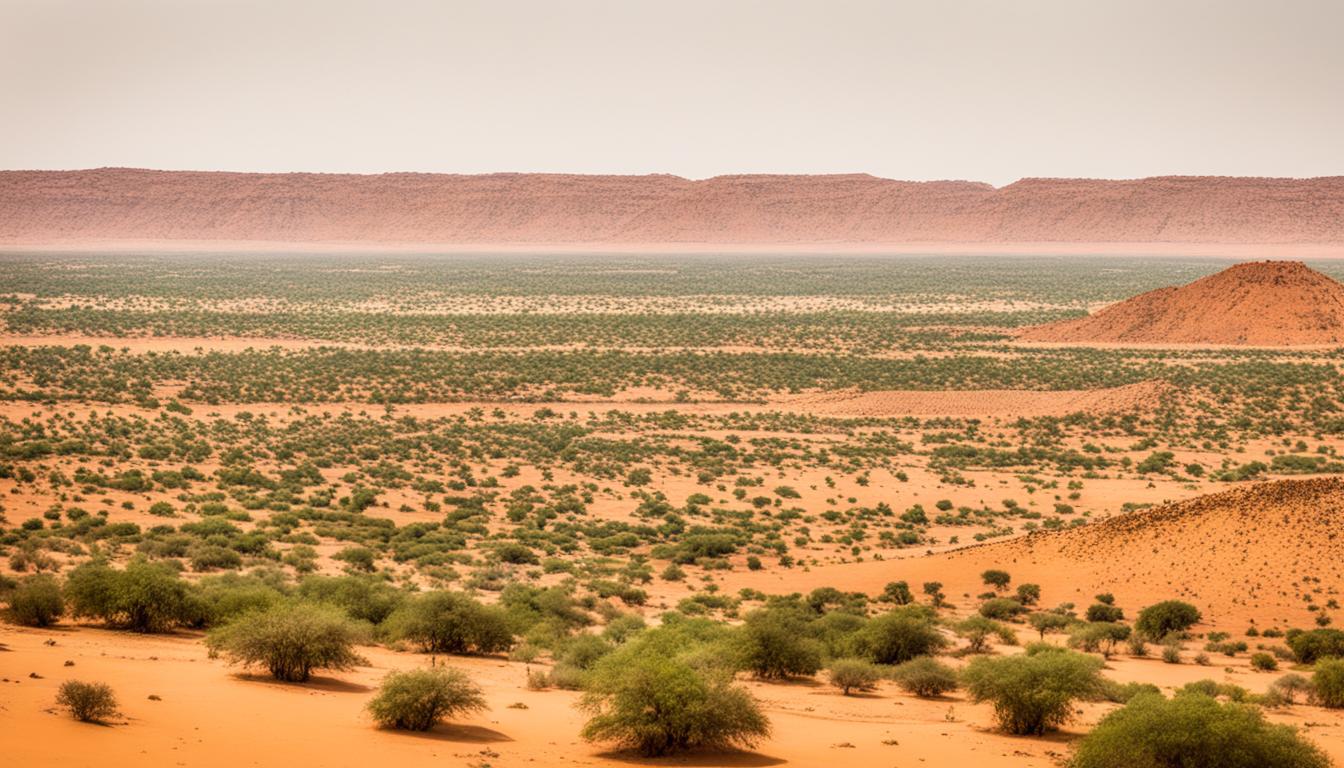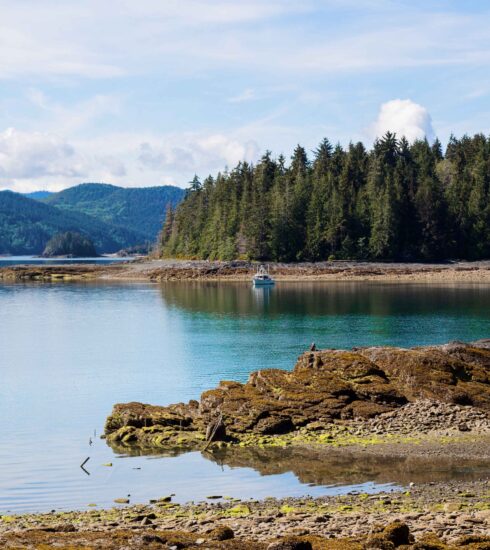Kiribati Biodiversity: Animal and Plant Species and What Is Under Threat
Kiribati, a low-lying island nation in the Pacific, is renowned for its remarkable biodiversity. This article explores the diverse animal and plant species that call Kiribati home and the threats they face. Conservation plays a critical role in protecting these valuable resources and preserving the fragile island ecosystems.
Key Takeaways
- Kiribati is home to a rich diversity of animal and plant species.
- Climate change, habitat destruction, and invasive species pose significant threats to Kiribati’s biodiversity.
- Conservation efforts are essential for the sustainable development of Kiribati and the preservation of its unique island ecosystems.
- Kiribati has established protected areas and developed a Biodiversity Action Plan to safeguard critical habitats and species.
- Collaboration with NGOs, local communities, and international partners is vital for the success of biodiversity conservation initiatives in Kiribati.
Biodiversity in Kiribati
Kiribati, located in the Pacific, boasts a remarkable level of biodiversity, particularly in its marine ecosystems. The region is teeming with various marine life, making it a haven for divers and researchers alike. From vibrant coral reefs to unique fish species, the marine environment in Kiribati is a thriving ecosystem that supports a wide array of life.
One of the highlights of Kiribati’s biodiversity is the presence of numerous endemic species. These plants and animals are exclusively found in this region and contribute to the country’s ecological uniqueness. By having such high levels of species endemism, Kiribati becomes an essential area for conservation efforts, ensuring the survival of these remarkable species for future generations.
However, terrestrial biodiversity in Kiribati faces certain challenges. The limited land size, fragile environment, and low soil fertility of the atoll islands result in relatively poor terrestrial biodiversity. Nonetheless, the islands still harbor a diverse range of indigenous terrestrial fauna, including various bird species, insects, and land crabs.
Indigenous Terrestrial Fauna in Kiribati
Kiribati’s indigenous terrestrial fauna primarily consists of:
- Birds: The islands are home to several bird species, such as the endemic Kiribati reed warbler and the Christmas Island frigatebird.
- Insects: Various insect species contribute to the terrestrial biodiversity, including beetles, butterflies, and bees.
- Land Crabs: The atolls of Kiribati provide habitats for land crabs, such as the coconut crab, known for its impressive size and strength.
These terrestrial species play a vital role in the island ecosystems, contributing to pollination, seed dispersal, and nutrient cycling. Protecting and conserving these species is crucial for maintaining the delicate balance of Kiribati’s biodiversity.
Exploring Kiribati’s Marine Marvels
Kiribati’s marine ecosystems are a treasure trove of biodiversity, making it a destination of fascination for divers, ecologists, and nature enthusiasts. The coral reefs in Kiribati are diverse and vibrant, home to numerous colourful fish species, including parrotfish, butterflyfish, and clownfish.
In addition to the abundant fish population, Kiribati’s marine environment supports the existence of other remarkable creatures. Sea turtles, such as hawksbill and green turtles, gracefully glide through the waters, while majestic manta rays gracefully navigate the currents. Furthermore, visitors may also encounter species like dolphins, sharks, and pelagic fish during their explorations.
These marine ecosystems are not only important for their beauty and recreational value but also for sustaining livelihoods and providing food security for the I-Kiribati people. The marine resources contribute significantly to the local economy, offering income opportunities through fishing and tourism.
“The oceans are a source of life and sustenance for our people. We must protect them for future generations.” – Her Excellency Taneti Maamau, President of Kiribati
| Key Features of Kiribati’s Marine Ecosystems | Marine Life |
|---|---|
| Biodiversity | Rich and diverse species, including numerous fish, corals, sea turtles, and rays. |
| Coral Reefs | Vibrant and extensive coral formations with unique and delicate structures. |
| Fish Species | Colourful and fascinating fish species, ranging from small reef dwellers to large pelagic fish. |
| Threatened Species | Some species, such as certain sea turtle species, face threats and require conservation efforts. |
| Ecosystem Services | Contribute to coastal protection, carbon sequestration, and sustainable fisheries. |
The marine ecosystems of Kiribati are undoubtedly crucial for the country’s cultural, economic, and ecological well-being. Recognizing the significance of these marine resources, efforts are underway to protect and conserve Kiribati’s marine biodiversity, ensuring the sustainability of these valuable ecosystems for generations to come.
Causes and Consequences of Biodiversity Loss
One of the greatest challenges facing the biodiversity in Kiribati is the ongoing threat of biodiversity loss. This loss can be attributed to several factors, including climate change, habitat destruction, and the introduction of invasive species. Let’s explore each of these causes and the consequences they have on the delicate ecosystems of Kiribati.
Climate Change and Biodiversity Loss
Climate change poses a significant threat to biodiversity in Kiribati. Rising sea levels and changing weather patterns have a direct impact on the island’s ecosystems. As sea levels rise, coastal habitats are being inundated, leading to the loss of vital nesting sites for seabirds and important breeding grounds for marine life. Additionally, increased temperatures and changes in rainfall patterns can negatively affect the distribution and survival of plant and animal species.
Habitat Destruction and Its Impacts
Habitat destruction, largely driven by human activities and infrastructure development, is another major cause of biodiversity loss in Kiribati. As development expands, natural habitats are cleared for urbanization, agriculture, or other forms of land use. This destruction disrupts the balance of ecosystems and displaces native species that rely on specific habitats for their survival. The loss of these habitats can lead to habitat fragmentation, decreasing the overall biodiversity and making species more vulnerable to extinction.
Invasive Species and Their Threat
Invasive species present a significant threat to the native flora and fauna of Kiribati. These species are introduced to the islands through human activities, such as the transportation of goods or accidental introduction. Once established, invasive species can outcompete native species, disrupt natural ecosystems, and even threaten the survival of endemic species. The lack of natural predators or controls for these invaders allows them to thrive and further impact the biodiversity of Kiribati.
“The consequences of biodiversity loss include the disruption of ecosystem functioning, the loss of valuable genetic resources, and the potential collapse of food chains.”
The Consequences of Biodiversity Loss
The loss of biodiversity in Kiribati has far-reaching consequences for the delicate balance of its ecosystems. When species are lost, ecosystem functioning is disrupted, which can lead to cascading effects throughout the food web. As species disappear, valuable genetic resources that could hold the key to medical advancements or crop resilience are lost forever. The potential collapse of food chains can also impact human populations that rely on the natural resources provided by these ecosystems.

The consequences of biodiversity loss are illustrated by the image above, which showcases the impact of habitat destruction on the delicate ecosystems of Kiribati.
National Conservation Efforts
Kiribati recognizes the importance of conservation and is actively engaged in various initiatives to protect and preserve its rich biodiversity. The country has established protected areas that serve as sanctuaries for critical habitats and species. These areas are carefully managed to ensure the conservation of diverse ecosystems and the promotion of sustainable development. By designating protected areas, Kiribati aims to safeguard its unique natural heritage from the threats posed by climate change, habitat destruction, and invasive species.
In addition to the establishment of protected areas, the government of Kiribati has developed a comprehensive Biodiversity Action Plan. This plan outlines strategies and actions to address the challenges facing biodiversity in the country. It serves as a roadmap for conservation efforts, providing a framework for coordinated action and the implementation of effective measures to protect and sustainably manage biodiversity.
“Our Biodiversity Action Plan is a testament to our commitment to conservation. It outlines our vision to conserve our natural resources and promote sustainable development for the benefit of present and future generations,” says Dr. Teburoro Tito, Minister of Environment and Natural Resources Development.
To achieve the objectives outlined in the Biodiversity Action Plan, collaboration is essential. The government of Kiribati works closely with non-governmental organizations (NGOs), local communities, and international partners to implement conservation initiatives effectively. By engaging multiple stakeholders, Kiribati maximizes its resources and expertise, leveraging collective efforts towards the preservation of its unique biodiversity.
Collaborative Conservation Efforts
Local communities and indigenous knowledge play a crucial role in implementing conservation efforts in Kiribati. Recognizing the significance of traditional ecological practices and community engagement, the government actively involves communities in decision-making processes and capacity-building initiatives. These efforts empower communities to take ownership of biodiversity conservation and foster a sense of shared responsibility.
International partnerships also contribute to the success of conservation efforts in Kiribati. Collaboration with regional and global organizations provides access to expertise, funding, and technical support. Through these partnerships, Kiribati gains valuable insights and benefits from knowledge exchange to enhance its conservation programs.
Looking Ahead
Kiribati’s commitment to conservation and the preservation of its biodiversity remains steadfast. Efforts to protect and conserve the country’s natural heritage continue to evolve, adapting to emerging challenges and opportunities. As Kiribati navigates its path towards sustainable development, it strives to strike a delicate balance between environmental conservation, social well-being, and economic growth.
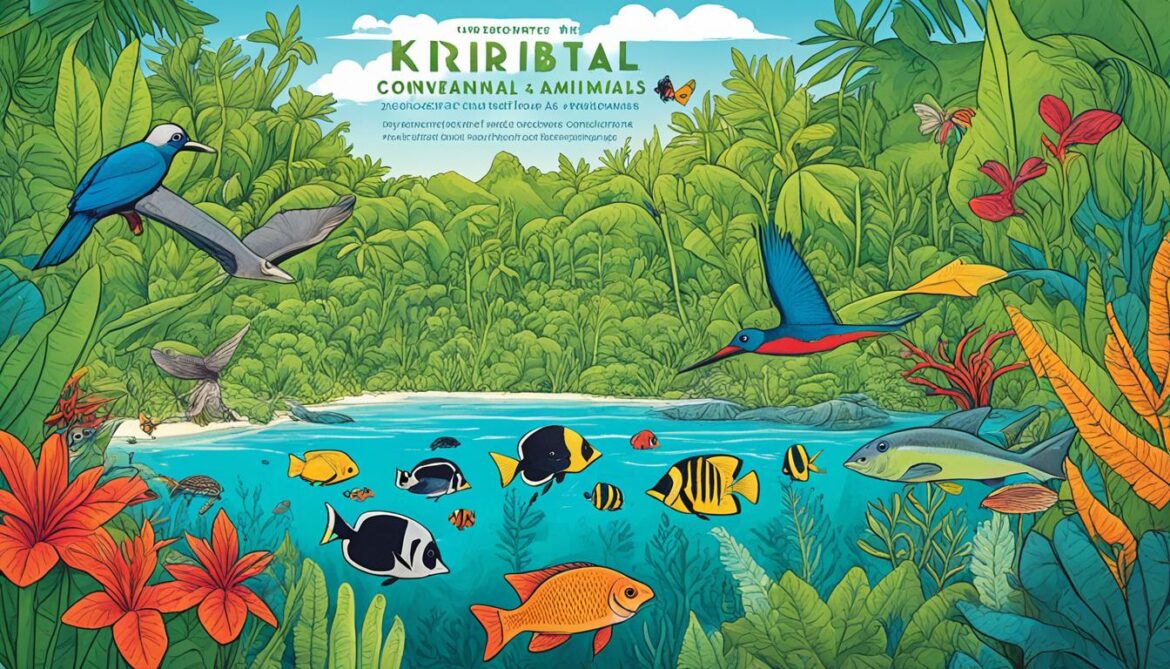
| Conservation Efforts | Protected Areas | Biodiversity Action Plan |
|---|---|---|
| Establishment of sanctuaries for critical habitats and species | Ecosystems and species safeguarded from threats | Strategies and actions to address biodiversity challenges |
| Collaboration with NGOs, local communities, and international partners | Effective management and conservation of diverse ecosystems | Framework for coordinated action and sustainable management |
| Empowerment of local communities and indigenous knowledge | Shared responsibility and community engagement | Integration of traditional ecological practices |
| Partnerships with regional and global organizations | Access to expertise, funding, and technical support | Knowledge exchange and capacity-building opportunities |
Assessing Kiribati’s Biodiversity
The International Union for Conservation of Nature (IUCN) has conducted assessments of Kiribati’s biodiversity using the Red List of Threatened Species. These assessments have provided valuable information on the status of species in the region, contributing to our understanding of Kiribati’s unique and diverse ecosystem.
While there are still gaps in our knowledge, these assessments have shed light on the presence of threatened species within Kiribati’s borders. The IUCN’s Red List helps identify species at risk and raises awareness about the need for their conservation.
Recognizing the importance of accurate assessments, the IUCN acknowledges the need for regional guidelines to evaluate both endemic and non-endemic species. The creation of a Regional Red List specifically for the Pacific islands, including Kiribati, will provide a comprehensive overview of threatened species and support targeted conservation efforts.
“The Regional Red List for the Pacific islands will guide conservation actions and prioritize efforts to protect vulnerable species in Kiribati and the surrounding region,” says Dr. Amanda Wilson, a biodiversity expert.
Such regional guidelines will enable conservation practitioners to focus their efforts on the species that require urgent attention and ensure that conservation actions are implemented effectively.
Detailed Assessments for Conservation
The IUCN’s Red List assessments take into account a range of factors to determine the conservation status of species, including population trends, habitat quality, and threats faced. These assessments are conducted using scientific data, expert knowledge, and field surveys.
By providing a comprehensive overview of Kiribati’s biodiversity, these assessments also support the development of conservation strategies and initiatives. They inform decision-making processes and enable organizations, such as the Kiribati Department of Environment and Conservation, to prioritize conservation actions based on the identified threats and the vulnerability of species.
Challenges and Future Directions
While these assessments are essential for understanding Kiribati’s biodiversity, there are challenges to overcome. Limited resources and gaps in scientific knowledge pose ongoing hurdles in conducting comprehensive assessments. Capacity building efforts, both within Kiribati and through collaboration with international partners, are crucial to address these challenges and enhance biodiversity assessment capabilities.
Furthermore, ongoing monitoring and reassessments are needed to keep track of changes in species populations and conservation statuses over time. This will allow for adaptive conservation management that can respond to new threats and emerging conservation priorities.
Overall, the IUCN’s Red List assessments and the development of regional guidelines provide a framework for assessing and conserving Kiribati’s biodiversity. These efforts ensure that conservation initiatives are evidence-based, effective, and targeted at the most vulnerable species, contributing to the long-term preservation of Kiribati’s unique natural heritage.
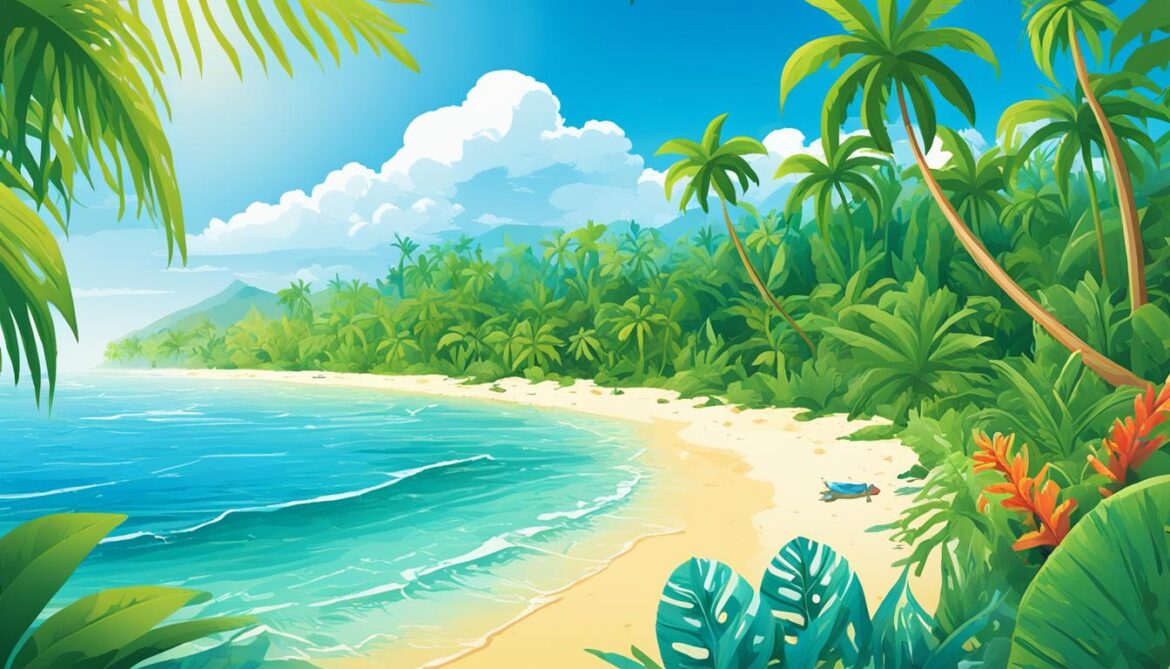
Importance of Biodiversity for Food and Agriculture
Biodiversity plays a crucial role in ensuring food security and sustaining livelihoods in Kiribati. The rich marine resources provide the main source of protein and income for the I-Kiribati people.
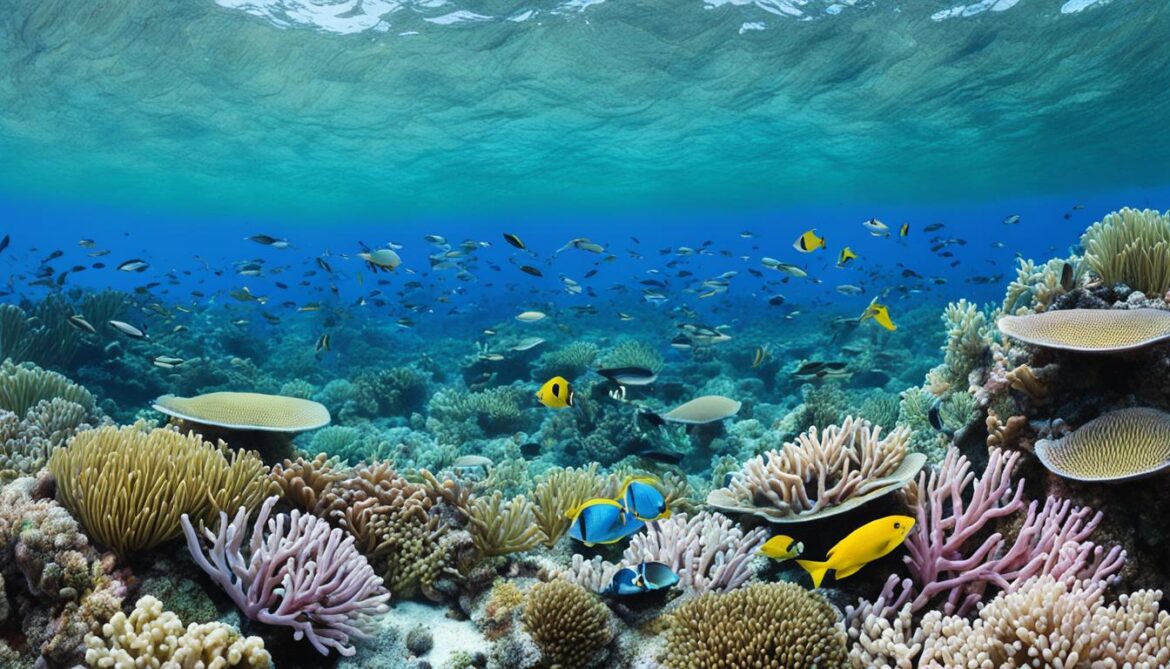
Terrestrial biodiversity resources, although limited, contribute to the production systems of food and regulate the balance of agroecosystems and coastal marine habitats.
Protecting and managing associated biodiversity, ecosystem services, and wild foods are essential for maintaining a sustainable food supply and improving socio-economic well-being.
“Biodiversity is not just about the number of different species. It also includes the genetic diversity within each species and the variety of ecosystems that they form. All of this together provides a powerful toolbox that underpins the provision of food, fuel, and fiber; the purification of air and water; the detoxification and decomposition of wastes; the control of pests and diseases; and many other essentials that we take for granted.” – World Wildlife Fund
Benefits of Biodiversity for Food and Agriculture
- Ecosystem services: Biodiverse ecosystems provide a range of services that support agricultural production, including pollination, soil fertility, water purification, and pest control.
- Resilience to climate change: Diverse ecosystems are more resilient to climate change impacts, such as extreme weather events and changing growing seasons, ensuring the availability of food in the face of adversity.
- Genetic resources: Biodiversity is a valuable source of genetic resources that can be used to develop climate-resilient crops and improve agricultural productivity.
- Nutrition and food diversity: Biodiversity provides a wide range of plant and animal species that contribute to a diverse and nutritious diet, reducing the risks of malnutrition and food-related diseases.
- Livelihoods and income: Marine resources and other biodiversity components are critical for the livelihoods and income generation of local communities, contributing to poverty reduction and sustainable development.
By recognizing the importance of biodiversity for food and agriculture, Kiribati can implement measures to protect and conserve its natural resources, ensuring the long-term sustainability of its food supply and the well-being of its people.
| Biodiversity for Food and Agriculture | Benefits |
|---|---|
| High marine biodiversity | Provides a source of protein and income for I-Kiribati people |
| Terrestrial biodiversity | Contributes to food production and regulates agroecosystems and coastal marine habitats |
| Ecosystem services | Pollination, soil fertility, water purification, pest control |
| Resilience to climate change | Ensures food availability in the face of climate impacts |
| Genetic resources | Used to develop climate-resilient crops and improve agricultural productivity |
| Nutrition and food diversity | Contributes to diverse and nutritious diets |
| Livelihoods and income | Contributes to poverty reduction and sustainable development |
Policies and Institutions for Biodiversity Conservation
Kiribati recognizes the importance of biodiversity conservation and has implemented a range of policies, programmes, and institutions to support these efforts. The government collaborates closely with various stakeholders, including NGOs, local communities, and regional and international partners. By working together, these stakeholders can effectively protect and manage the country’s unique biodiversity.
One of the key focuses of these policies is capacity building. Kiribati understands the need to enhance knowledge and skills in biodiversity conservation to ensure the long-term success of conservation efforts. Through capacity building initiatives, individuals and organizations involved in conservation can develop the necessary expertise and capabilities to address the challenges faced by biodiversity in Kiribati.
“Capacity building is crucial for promoting effective biodiversity conservation in Kiribati. By equipping stakeholders with the skills and knowledge needed to address the threats to biodiversity, we can work towards a more sustainable future for our unique ecosystems.” – Dr. Katalina Tekina, Minister of Environment and Sustainable Development
These policies and capacity building efforts are aimed at strengthening Kiribati’s conservation capabilities. By fostering collaboration, knowledge sharing, and skill development, the country can enhance its capacity to protect and manage biodiversity effectively. This is essential for ensuring the preservation of Kiribati’s precious natural heritage for future generations.
Stakeholder Engagement
Stakeholder engagement is a critical aspect of biodiversity conservation in Kiribati. The government recognizes the value of involving NGOs, local communities, and other stakeholders in decision-making processes and conservation initiatives. This inclusive approach ensures that diverse perspectives and local knowledge are taken into account, leading to more effective and sustainable outcomes.
Collaboration with International Partners
Kiribati actively collaborates with international partners to strengthen its biodiversity conservation efforts. Partnerships with organizations such as the United Nations Development Programme (UNDP) and the Pacific Community (SPC) provide valuable support in the form of technical expertise, funding, and access to regional networks. These collaborations enable Kiribati to leverage international resources and knowledge in its conservation endeavors.
Monitoring and Evaluation
A robust monitoring and evaluation system is in place to assess the effectiveness of biodiversity conservation policies and programs in Kiribati. Regular assessments and data collection allow for evidence-based decision making and adaptive management strategies. The monitoring and evaluation process ensures that conservation efforts are continuously improved and aligned with the changing needs and challenges of biodiversity protection.
| Conservation Policies | Stakeholders | Capacity Building |
|---|---|---|
| Kiribati has implemented policies to support biodiversity conservation. | The government collaborates with NGOs, local communities, and international partners. | Capacity building efforts enhance knowledge and skills in biodiversity conservation. |
| Policies focus on protecting and managing biodiversity effectively. | Stakeholder engagement ensures diverse perspectives are considered. | Capacity building strengthens Kiribati’s conservation capabilities. |
| The government collaborates with international partners for support. | Collaboration with international partners provides technical expertise and funding. | Monitoring and evaluation assess the effectiveness of conservation efforts. |
Kiribati’s commitment to conservation policies, stakeholder engagement, and capacity building positions the country as a leader in biodiversity protection. Through these initiatives, Kiribati is taking proactive steps to safeguard its natural heritage and promote sustainable development.
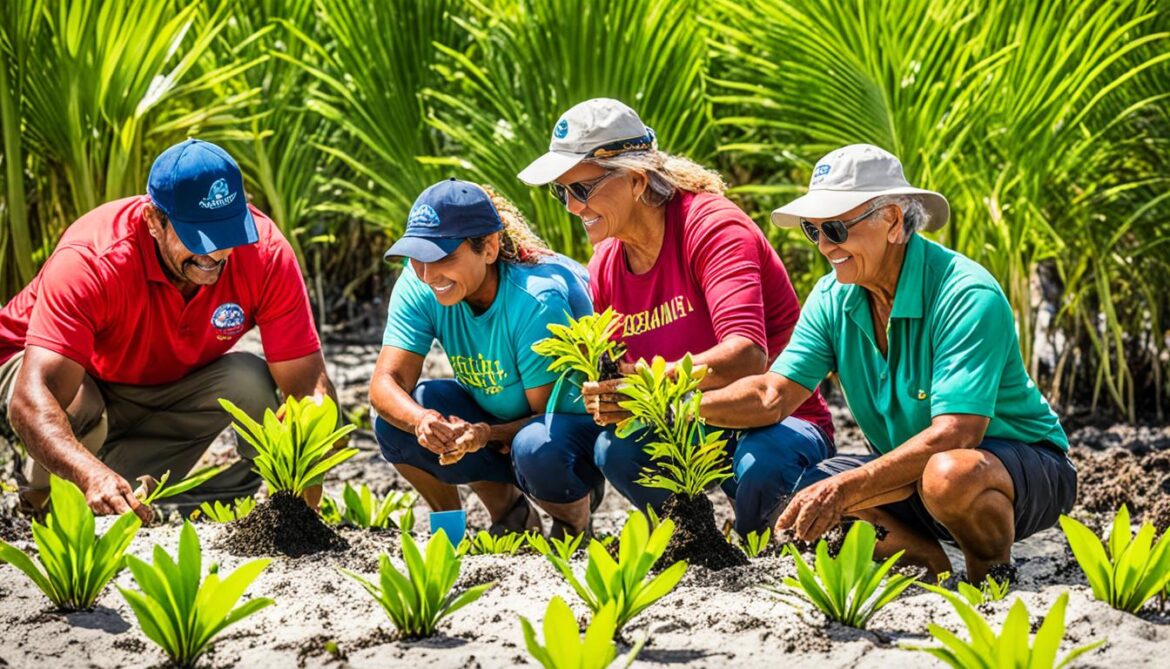
Challenges and Priorities for Biodiversity Conservation
Kiribati faces several challenges in the conservation of its rich biodiversity. One of the primary challenges is the economic constraints that the country experiences. Limited financial and human resources hinder the implementation of comprehensive conservation efforts. These economic constraints make it difficult to allocate sufficient funds and manpower to biodiversity conservation initiatives.
Another significant challenge is the impacts of climate change on Kiribati’s biodiversity. Rising sea levels and changing weather patterns pose a threat to the delicate balance of ecosystems and the survival of many plant and animal species. Adapting to and mitigating the effects of climate change on biodiversity requires innovative strategies and collaborative approaches.
Given the limited resources available, it is crucial to prioritize specific areas for conservation. These priority areas include the establishment and protection of conservation areas that serve as sanctuaries for vulnerable species and habitats. Effective ecosystem management is key to maintaining the health and resilience of Kiribati’s unique ecosystems.
Species conservation is also a priority, focusing on the protection of endemic species found solely in Kiribati. These species are particularly vulnerable to threats such as habitat destruction and the introduction of invasive species. Efforts to control and eradicate invasive species play a crucial role in safeguarding native biodiversity.
Communication and education are vital components of biodiversity conservation. Raising awareness among the local communities about the importance of biodiversity and the role they can play in its protection is essential for long-term sustainability. Building capacity within local communities to actively participate in conservation initiatives empowers them to become stewards of their natural environment.
Preserving traditional knowledge related to biodiversity is crucial for sustainable conservation efforts. Indigenous communities in Kiribati possess valuable knowledge and practices that have sustained the delicate balance between humans and nature for generations. Recognizing and incorporating traditional knowledge into conservation strategies can contribute to more effective and culturally sensitive approaches.
Sound environmental governance is essential to ensure that biodiversity conservation efforts are integrated into policies and regulations. Strengthening research and information systems provides the scientific basis for conservation decision-making and enables ongoing monitoring of biodiversity trends.
Lastly, community engagement is a cornerstone of successful biodiversity conservation initiatives. Encouraging active participation and involvement of local communities fosters a sense of ownership and responsibility for their natural heritage. Collaborative partnerships between government, NGOs, and communities are key to achieving sustainable conservation outcomes.
“Conserving biodiversity requires the collective efforts of all stakeholders. By working together and addressing the economic constraints, climate change impacts, and limited resources, we can ensure the preservation of Kiribati’s unique natural heritage for future generations.”
Priorities for Biodiversity Conservation in Kiribati
| Priority Areas | Description |
|---|---|
| Protected and Conservation Areas | Establishing and managing protected areas that preserve critical habitats and species. |
| Ecosystem Management | Implementing sustainable practices to maintain the health and resilience of ecosystems. |
| Species Conservation | Protecting and preserving endemic and threatened species through targeted conservation efforts. |
| Communication and Education | Increasing awareness and understanding of biodiversity among local communities through outreach and educational programs. |
| Capacity Building | Equipping local communities and stakeholders with the necessary knowledge and skills to actively participate in conservation initiatives. |
| Invasive Species Control | Implementing measures to prevent the introduction and control the spread of invasive species. |
| Traditional Knowledge Preservation | Recognizing and incorporating traditional knowledge and practices into conservation strategies. |
| Environmental Governance | Developing and enforcing policies and regulations that promote biodiversity conservation. |
| Research and Information | Investing in scientific research and monitoring to inform conservation decision-making. |
Community engagement and collaboration are at the heart of these priorities, as they ensure the success and sustainability of biodiversity conservation efforts in Kiribati.
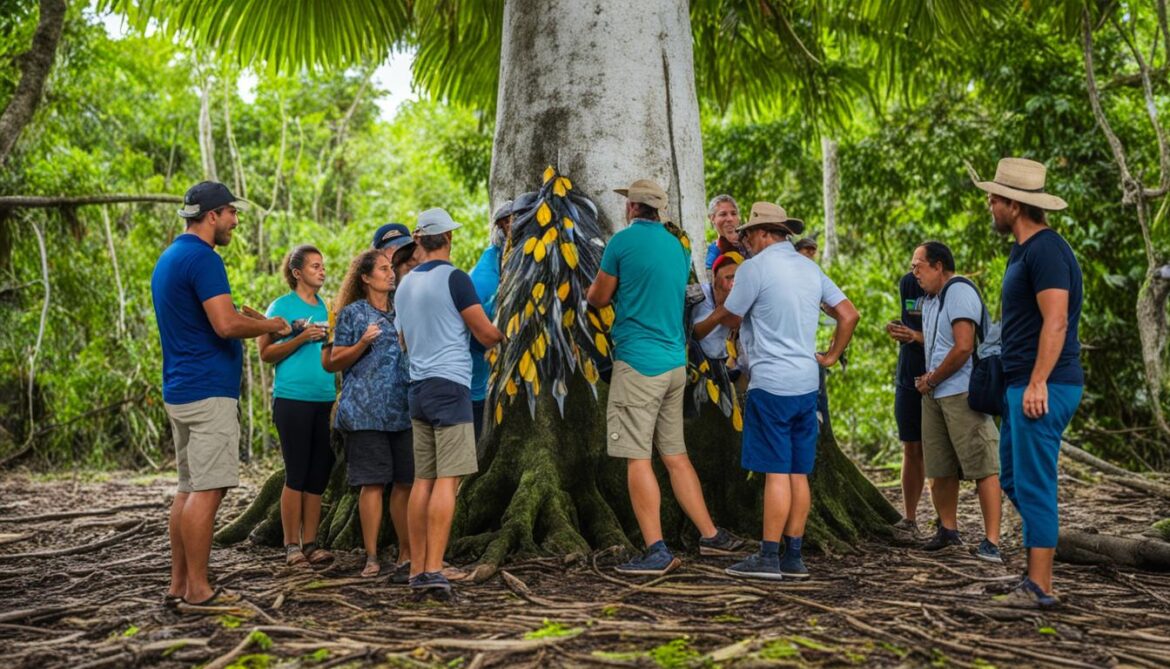
Conclusion
Kiribati’s rich biodiversity is vital for the sustainable development of the country. Conservation efforts are necessary to safeguard the diverse ecosystems, support local livelihoods, and ensure food security. Through collaboration with stakeholders and the implementation of policies and action plans, Kiribati is actively working towards preserving and sustainably utilizing its unique biodiversity.
Continued support and engagement from local communities and international partners are crucial for the success of these conservation initiatives. By valuing and protecting Kiribati’s biodiversity, we can create a brighter future for both the environment and the people of Kiribati. Together, we can build a sustainable and resilient future, where biodiversity conservation and sustainable development go hand in hand.
Preserving Kiribati’s unique biodiversity not only benefits the country but also contributes to global conservation efforts. By learning from and implementing successful strategies, Kiribati can serve as a model for other nations facing similar challenges. Let us continue striving towards a future where biodiversity thrives, ecosystems flourish, and sustainable development paves the way for a better world.




